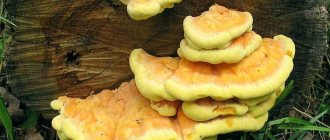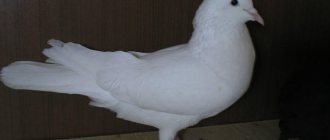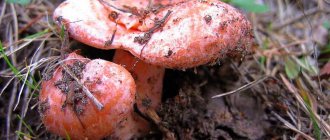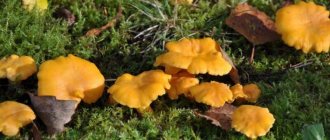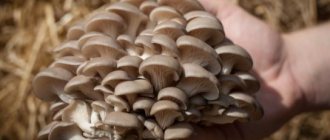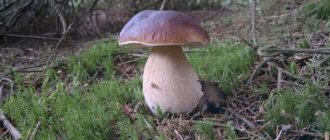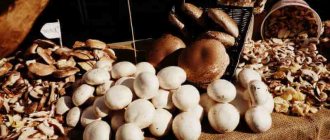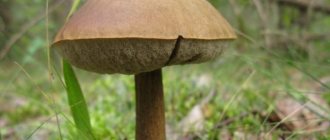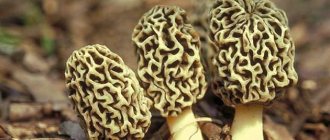The main objective
Why do mushrooms grow on our planet? So that a person can find them and fry them with potatoes? Not at all. Fruiting bodies growing on the surface of the earth, on trees, or any other suitable substrate are the reproductive organs of the main, main part of the fungus - the internal underground mycelium, which, in the depths of the substrate, can cover an area of up to many hundreds of kilometers. The main purpose of terrestrial fruiting bodies is to grow and spray life-giving spores into the external environment, and thus ensure further proliferation of the mycelium. Therefore, for the mushrooms themselves, their most important part is the hymenophore, their spore-bearing layer.
There are six types of hymenophore structure, found in a wide variety of fungal species. Among the cap mushrooms most often collected and consumed by humans, the most common are those with the Tubular and Lamellar type of hymenophore.
Tubular and Lamellar Mushrooms – different in appearance, the same in essence
Answers to common questions
Are inedible and poisonous tube mushrooms the same thing?
Among the tubular ones, there are species that are inedible and poisonous. These two concepts are considered one, since their common feature is an extremely unpleasant bitter taste and smell. Although the amount of toxins in them is small, consuming them can cause food poisoning.
Do trumpet mushrooms that grow on trees eat?
Those that parasitize trees are classified as inedible. They are life-threatening and their fruiting bodies can be harmful to health. They cannot be collected even despite their external resemblance to edible representatives and attractive appearance.
Which tubular mushrooms are eaten raw?
You can eat porcini mushrooms raw, for example, in salads. But, as a rule, only caps are used for such dishes.
Poisonous varieties of the species in question are quite rare, and their list is very short. That is why collecting tubular mushrooms is preferable for beginners, because the likelihood of making a mistake is very small. Edible species are distinguished by high taste and aromatic qualities; they are quite simple to process and prepare.
Lamellar Mushrooms
Lamellar Fungi are a group of basidiomyceous fungi with a lamellar hymenophore structure. “Basidial” is a division of the fungal kingdom that includes species that produce spores in special club-shaped structures called basidia. In the old days, all species with a similar hymenophore structure were classified as members of the agaricaceae family, but later mycologists scattered them into different orders and families.
Tubular and Lamellar Mushrooms – different in appearance, the same in essence
In most lamellar mushrooms, the fruiting bodies are annual and fleshy, and the hymenophore is located on the lower part of the cap and looks like many radial stripes - plates running from the center to the edges of the cap. They can look completely different - be very thin, loose and dense, or, on the contrary, hard and sparsely spaced, can be colored to match the rest of the fruiting body, or have a completely different color from it - there are a huge number of options in nature.
Tubular and Lamellar Mushrooms – different in appearance, the same in essence
The plates can be placed strictly under the surface of the cap or extend gently onto the stem; they often have bridges between them. The structure and color of the plates is often the most important factor in accurately determining the type of fungus.
The fruiting body of lamellar mushrooms is usually more fragile and brittle than that of tubular mushrooms, and the stem often has a cavity inside.
Some types of lamellar mushrooms have the property of releasing moisture from the surface of the hymenophore; also, in many species, in youth, the hymenophore plates are covered with a special protective membrane - a blanket, which breaks as the fruiting body matures, often leaving a characteristic film ring in the upper part of the stem.
Tubular and Lamellar Mushrooms – different in appearance, the same in essence
Inedible mushrooms: photos and names
The main difference between hallucinogenic drugs and other types is that they have a psychotropic effect. Their action is in many ways similar to narcotic substances, therefore their intentional collection and use is punishable by criminal liability.
Common hallucinogenic varieties include (Figure 6):
- The red fly agaric is a common inhabitant of deciduous forests. In ancient times, tinctures and decoctions from it were used as an antiseptic, immunomodulatory agent and intoxicant for various rituals among the peoples of Siberia. However, it is not recommended to eat it, not so much because of the hallucination effect, but because of severe poisoning.
- Stropharia shit gets its name from the fact that it grows directly on piles of feces. Representatives of the variety are small, with brown caps, sometimes with a shiny and sticky surface.
- Paneolus bellflower (bell asshole) also grows mainly in soils fertilized with manure, but can also be found simply on swampy plains. The color of the cap and stem is from white to gray, the flesh is gray.
- Stropharia blue-green prefers the stumps of coniferous trees, growing on them singly or in groups. You won't be able to eat it by accident, as it has a very unpleasant taste. In Europe, this stropharia is considered edible and is even bred on farms, while in the USA it is considered poisonous due to several deaths.
Figure 6. Common hallucinogenic varieties: 1 - red fly agaric, 2 - stropharia shit, 3 - paneolus bell-shaped, 4 - blue-green stropharia
Most hallucinogenic species grow in places where edible ones simply will not take root (too swampy soils, completely rotten stumps and piles of manure). In addition, they are small, mostly on thin legs, so it is difficult to confuse them with edible ones.
All poisonous varieties are in one way or another similar to edible ones (Figure 7). Even the deadly pale grebe, especially young specimens, can be confused with russula.
For example, there are several boletus doubles - Le Gal boletus, beautiful and purple, which differ from the real ones by the too bright color of the stem or cap, as well as the unpleasant smell of the pulp. There are also varieties that are easily confused with honey mushrooms or russula (for example, fiber and govorushka). Gall is similar to white, but its pulp has a very bitter taste.
Figure 7. Poisonous counterparts: 1 - purple boletus, 2 - gall mushroom, 3 - royal fly agaric, 4 - yellow-skinned champignon
There are also poisonous doubles of honey mushrooms, which differ from the real ones in the absence of a leathery skirt on the leg. Poisonous varieties include fly agarics: toadstool, panther, red, royal, stinking and white. Cobwebs are easily disguised as russula, saffron milk caps or boletuses.
There are several types of poisonous champignons. For example, the yellow-skinned one is easy to confuse with a regular edible specimen, but when cooked it gives off a pronounced unpleasant odor.
Examples of Lamellar Mushrooms
Russula Edible Russula Vesca
Tubular and Lamellar Mushrooms - different in appearance, the same in essence.
The famous Russian edible mushroom, very tasty and popular among lovers of quiet hunting. It grows from early summer to late autumn in deciduous and coniferous forests. It has a fleshy pinkish-brown cap, hemispherical in youth, and flat-convex in mature specimens.
The lamellar hymenophore of this species noticeably contrasts with the cap, is white in color, just like the leg, and becomes covered with rusty spots with age.
Common Chanterelle or Real Chanterelle, Cantharellus cibarius
Tubular and Lamellar Mushrooms are different in appearance, but essentially the same.
A species from the genus Chanterelle, the Chanterelle family. One of the favorite trophies of Russian mushroom pickers, with a rich and delicate taste.
It has a characteristic funnel-shaped fleshy cap of orange-yellow color, up to 10 cm in diameter and a dense, monochromatic and tapering stem fused with it. The flesh of the chanterelle is dense and elastic, the same orange color and with a pleasant fruity smell.
The hymenophore plates of the chanterelle are colored in the general tone of the fruiting body and extend far down the stalk.
The chanterelle grows from early summer until late autumn, in forests of all types, but especially loves mossy coniferous oak forests. In mid-summer, at the peak of the season, it can occur in huge numbers at the same time.
The most terrible and dangerous mushroom in the world also belongs to the lamellar type.
Pallid Grebe Amanita Phalloides
Tubular and Lamellar Mushrooms are different in appearance, but the same in essence.
Its lamellar hymenophore is distinguished by its stable white color with a slight greenish tint, which does not change as the fruiting body ages, which serves as one of the identifying signs of this deadly poisonous forest dweller.
Varieties and description
Among the mushrooms of this group there are both edible ones and those that absolutely cannot be eaten, so it is worth knowing their differences.
Edible
Most trumpet mushrooms are edible. They are boiled, fried, pickled and dried. With any type of processing they do not lose their high taste qualities. The list below provides information about which species are considered edible:
- Boletuses. They grow in small families in coniferous forests in a temperate climate zone. They have light white or yellow flesh and a characteristic odor. Their legs are dense and thickened at the base, have a mesh surface, less often - smooth. Spore powder comes in many shades of brown.
Sometimes they are confused with gall poisonous specimens. You can check whether the butterdish is edible by its external characteristics: the inside of the poisonous cap is colored lilac. However, the taste of boletus is indistinguishable from poisonous representatives due to bitterness. Moss flyers. Mostly found on sandy soils. A distinctive feature is the blue discoloration of the flesh when it is broken. Unlike the above specimens, moss mushrooms have a mediocre taste. When collecting them, you should be careful not to cut off the false moss. The characteristics of the latter are small size, dirty brown flesh, which turns red when damaged.
Poisonous
Among the tubular mushrooms there are poisonous specimens, including:
- Gall fungus, also often called false white. Has a wide distribution area. Predominantly found in forested areas where sandy soil predominates. Less common on stumps and bases of tree trunks. The mushroom grows either singly or in groups, appears in July and is available until October.
It has a brown or brownish hemisphere-shaped cap with a yellow tint. The tubular layer is dirty pink, with small pores. The stalk is tuberous at the base and gradually extends closer to the cap. The flesh is white, hard to the touch and bitter in taste due to the toxins it contains. The specific taste led to another name - mustard. Pepper mushroom. Unlike the previous species, this representative is found much less frequently, most often in spruce forests. It can have either a convex or flat cap, velvety to the touch and a very bitter taste. The tubular layer has a red or copper tint, uneven and large pores. The leg is thin, tapering at the bottom and has a cylindrical shape.
Tubular Mushrooms
Tubular and Lamellar Mushrooms - different in appearance, united in essence
Tubular fungi - a group of basidiomyceous higher fungi with a tubular hymenophore structure. The tubular hymenophore consists of many microscopic tubes, is located on the underside of the cap and looks very similar to a sponge. The cap of tubular mushrooms can have a variety of shapes, but is never completely flat.
Tubular and Lamellar Mushrooms – different in appearance, the same in essence
Examples of Tubular Mushrooms
This category includes many species from the Boletaceae and Maslenaceae families, including boletus, boletus, etc.
White mushroom, or Boletus Edulis
The same, most delicious and most important mushroom of the Russian forest. Belongs to the Borovik genus, Boletov family.
Tubular and Lamellar Mushrooms – different in appearance, the same in essence
Its cap is cushion-shaped, can reach a diameter of up to 25 cm and is painted in noble brown tones. The leg is thick and massive, with a downward expansion, up to 20 cm high and up to 5 cm thick. Borovik's pulp is dense, thick and white, with a characteristic pleasant nutty smell.
Borovik grows from the very beginning of summer until the end of autumn in forests of all types. Being very friendly, it forms mycorrhizae with many tree species. It bears fruit in peculiar “waves” – early June/break/mid-July/break – and so on. The number of fruiting bodies gradually increases with each new wave until autumn.
There is no need to specifically mention the taste and culinary advantages of Borovik - they are already known to everyone.
The tubular spore-bearing layer of Borovik can be dried and artificially planted in the soil litter under young birch, pine, oak and spruce trees, thus creating an artificial plantation of these mushrooms.
Speckled Oak Boletus Erythropus
Tubular and Lamellar Mushrooms - different in appearance, the same in essence.
A close relative of Boletus, similar to it in weight and size, and growing from May to October in mosses on marshy soils. It has good taste and culinary qualities, but in this case, it is interesting to us because its tubular hymenophore has a characteristic color - from yellow-olive in youth to brick-red in mature specimens. And when pressed, the tubes turn poisonous blue.
Common boletus Léccinum scábrum
Tubular and Lamellar Mushrooms - different in appearance, the same in essence
Another favorite and desired object of quiet hunting in Russian forests.
It has a convex cap, initially hemispherical, then cushion-shaped, up to 15 cm in diameter. Its color varies from light gray to dark brown, depending on growing conditions. The cap looks smooth, but in wet weather it becomes slightly slimy.
The leg is cylindrical and solid, slightly widening downward, up to 15 cm long and up to 3 cm in diameter. It has a whitish-gray color and is covered on top with a pattern of brownish scales.
The boletus pulp is white, very aromatic and tasty.
The tubular hymenophore under the cap, initially light, turns gray over time. Very easy to separate from the cap.
The boletus grows from early summer to mid-autumn in deciduous forests, reaching its peak form by mid-summer. It forms mycorrhiza not only with birch, but also with many other species of deciduous trees.
The tubular structure of the hymenophore is also characteristic of fungi - tinder fungi, growing on tree trunks in places where the bark is damaged. In tinder fungi, the tubes of the spore-bearing layer grow very tightly with the flesh of the cap, not being separated from it as easily as in representatives of the boletaceae and oiler families. This category includes representatives of the families:
- Fistulinaceae
- Polypore
- Hymenochaetes
- Ganoderma
- Some species of the Porieceae family.
Example view
Poisonous mushroom Amanita - its types and characteristics
A poisonous mushroom such as fly agaric can be used for a variety of diseases, if prepared correctly, taking into account existing contraindications and the required dosage. Some of its types are edible, but in order to avoid consequences, they must undergo full heat treatment.
Description of the mushroom and its features
Fly agaric belongs to the lamellar mushrooms of the Amish family.
The bright, elegant appearance of this forest dweller is very deceptive - it is a poisonous fungal root, which is a symbiosis of mycelium (mycelium) with the roots of various plants and trees.
At the moment, there are more than 600 species of fly agarics in nature, and their color is not always bright red; the caps can be brown, yellow and white. The most famous varieties are royal, Caesar, panther, and red fly agaric.
Externally, the ordinary red fly agaric is a large, fleshy mushroom; its cap can be thinner or thicker, sometimes with a small tubercle.
White flakes are located along it - these are preserved tissue segments in the process of formation. The base of the leg expands towards the ground.
The ring or “skirt” in the upper part of the leg is a shell in which young individuals are enclosed; reproduction occurs with the help of spores.
Not everyone knows that the most poisonous mushroom, the toadstool, poisoning with which can lead to death, also belongs to the fly agaric family.
The diameter of its cap can be 10-14 cm, the leg is high - up to 12 cm. Just a few grams of this mushroom are enough for poisoning to lead to death.
A special feature of the toadstool is the presence of a filmy ring, thanks to which it can be distinguished from such similar floats, russula and champignons.
Composition and properties
The body of the mushroom contains several types of toxic components, which are mainly found in the cap and its skin; the stem has a lower content.
The chemical composition of the most common red fly agaric is represented by the following substances:
- muscimol is a hallucinogen that has a hypnotic, sedative effect and can disrupt the functioning of consciousness;
- ibotenic acid is a toxic substance that has a destructive effect on brain cells;
- muscarine is a natural alkaloid that leads to vasodilation and the inability of the heart to fully contract; as a result of its entry into the body, poisoning occurs with all the characteristic symptoms - decreased blood pressure, nausea and vomiting;
- muscaruphine is an antibacterial substance, which, moreover, has anti-inflammatory and antitumor properties, which makes it possible to use the mushroom for medical purposes;
- Muscazone is formed as a result of the breakdown of ibotenic acid and is characterized by a weak effect on the functioning of the nervous system.
Most toxic substances accumulate in fly agaric in spring and summer, and at this time it is especially dangerous.
Fly agarics feed on organic matter, since they are not able to absorb carbon dioxide from the air, and they also do not contain chlorophyll.
Microscopic amounts of these poisons are successfully used in pharmacology to create drugs for insomnia, joint diseases, colds, infectious diseases and cancer. Preparations created using fly agaric successfully heal wounds, relieve pain and spasms, increase immunity, and prevent bleeding.
Varieties
Fly agarics live, in fact, everywhere - species of this mushroom can be seen in deciduous and coniferous forests of Russia and many other countries. They are also found in colder areas, such as the tundra.
In addition to the red fly agaric, which grows everywhere, there are other varieties that differ in appearance:
- Toadstool or yellow toadstool. The mushroom has an unpleasant odor, a hemispherical white cap with snow-white spots. Most often, you can find it in coniferous or deciduous forests, from July to October.
- Panther fly agaric. It has a brown color, a cap from 5 to 12 cm and a cylindrical leg of approximately the same height with a porous surface and a low, fragile frill. It has an unpleasant smell and the flesh is white.
- Royal fly agaric. You can see it in an oak or beech grove, in a pine forest. This variety, when poisoned, can cause severe hallucinations. It is a large (brown or olive-colored) mushroom with a cap diameter of up to 20 cm and yellow flakes. The color of the pulp is yellow-brown and does not darken when cut. This mushroom loves forests with a predominance of birch, spruce and pine; it is widespread in our country, in Europe, and is found in Korea, England, and Alaska.
- Rough fly agaric. It is a small, fleshy, yellowish or olive-colored mushroom with a thick stalk. In young mushrooms, the cap is almost round and resembles a ball; in adults, it is flat, and the edges may slightly bend upward. When cut, the white flesh quickly turns yellow and its smell, unlike other types, is pleasant. Fly agaric grows both in Europe and America, Japan, South and Central Asia. In nature, however, it can be difficult to see; it prefers to grow next to hornbeams, beeches, and oak groves.
- Spiny-headed fly agaric (bristly, fat). This mushroom is distinguished by an umbrella fleshy head; in young individuals it is round. The cap is covered with gray warts. A distinctive feature is a thick white leg in the middle with scales at the base. The plates of an adult fly agaric are pink in color, the flesh is dense and has a pungent odor. Prefers symbiosis with coniferous trees and oaks, often growing near water bodies. This is a poisonous variety that can cause poisoning even after heat treatment.
Toadstool fly agaric
Panther fly agaric
Royal fly agaric
Fly agaric rough
Spiny-headed fly agaric
Almost all types of mushrooms are unusually beautiful - this is a kind of warning that they are deadly poisonous.
Is it possible to eat fly agarics?
Some types of fly agarics are considered conditionally edible. These include the following mushrooms:
- A yellowish-brown fly agaric, which is also popularly called a fly agaric. It is not particularly popular due to the fact that it has a thin cap and is not particularly fleshy, at the same time, it is so similar to a toadstool that many do not want to take risks. In its raw form, the float is poisonous and, indeed, dangerous, but after careful heat treatment it is quite suitable for food. The mushroom has a cap up to 8 cm in diameter, brown or brown-orange in color, it is flat, and in the center there is a small darker tubercle. The leg is fragile and high up to 15 cm with a thickening at the base. A distinctive feature is the absence of a ring on it. To the touch, the fly agaric is watery, with a coating of mucus, and there is no smell.
- The cone-shaped fly agaric is a thick-fleshy mushroom with a hemispherical cap, white or gray, covered with pointed pyramidal warts. The leg is cylindrical, wide at the base. This mushroom grows in coniferous and deciduous forests, often forming mycorrhiza with linden, beech, and oak. It contains small amounts of muscimol and ibotenic acid, so before use it is boiled and the broth is drained.
- Caesar mushroom is also edible and has excellent taste. Its differences from its poisonous counterparts: the cap is red-orange, smooth and without growths;
- plates and legs are golden yellow;
- the mushroom has a wide sac-like covering at the bottom of the stem.
Mushroom "Float"
Pineal fly agaric
Caesar's fly agaric
Also, edible varieties are brown, gray, snow-white floats, pink and tall fly agaric. Of course, they all require proper preparation and pre-boiling.
Application of mushrooms
As it turns out, the correct use of poisonous mushrooms can save a person from many ailments. They are used both externally and internally.
With a strictly calculated dosage, fly agaric is recommended for problems such as:
- skin diseases - diathesis, eczema, neurodermatitis;
- muscle and joint pain;
- headache;
- radiculitis and rheumatism;
- male impotence;
- eye diseases;
- diabetes;
- tuberculosis;
- epileptic seizures;
- oncological lesions.
And this is not a complete list of all the diseases for which this mushroom can help.
The common red fly agaric, which is the most common, can be used in the form of an alcohol tincture, juice, dried raw material, or ointment. All these remedies are used externally for varicose veins, for healing long-lasting wounds, for burns, bruises, and joint inflammation.
The tincture can be prepared with alcohol or vodka. The crushed caps should be kept in the refrigerator for three days, after which they are filled into a jar and poured 1 cm above the mushrooms. Leave the mixture for 15 days in a dark place and filter.
The ointment can be prepared from fresh mushrooms, grinding them into a paste and mixing with sour cream. Or first prepare the powder by drying the fly agaric caps, then grind them and add Vaseline or vegetable oil to them.
Today, special medicines based on poisonous mushrooms have already been released - fly agaric ointment, tincture, medicinal creams, homeopathic preparations.
Useful tips for choosing
When using mushrooms yourself, you need to be able to choose them correctly:
- the most useful, as well as harmful, substances are contained in the cap - this part must be intact, untouched by insects;
- when drying the caps, the plates are removed from them and then strung on a thread;
- when using, it is important to follow the recipe and the exact proportions of all ingredients;
- People with a diseased digestive system should avoid use;
- When making ointments and other products, metal utensils and metal utensils should be avoided.
This product is contraindicated in any form for people with mental disorders and pregnant (nursing) mothers.
At the end of use, it is advisable to thoroughly wash your hands with detergents; ideally, it is better to prepare a tincture or ointment while wearing rubber gloves. Internal preparations from fly agarics can only be taken after consultation with a treating specialist and under his supervision. For children, except in rare cases, mushroom-based medicines are not used.
It should be remembered that just four eaten fly agaric caps are enough to become poisoned without a chance of survival. Such poisonings may be accompanied by suffocation, delirium, convulsions and respiratory paralysis.
A poisonous mushroom, such as the fly agaric, is a living example of the inconsistency that is so characteristic of any living creature on our planet. On the one hand, it is extremely dangerous, on the other hand, it is beautiful, just like its appearance, and brings obvious benefits in the treatment of humans. All that remains is to use this undeniable gift of nature with respect and caution.
Source: https://ferma.expert/griby/muhomor/

